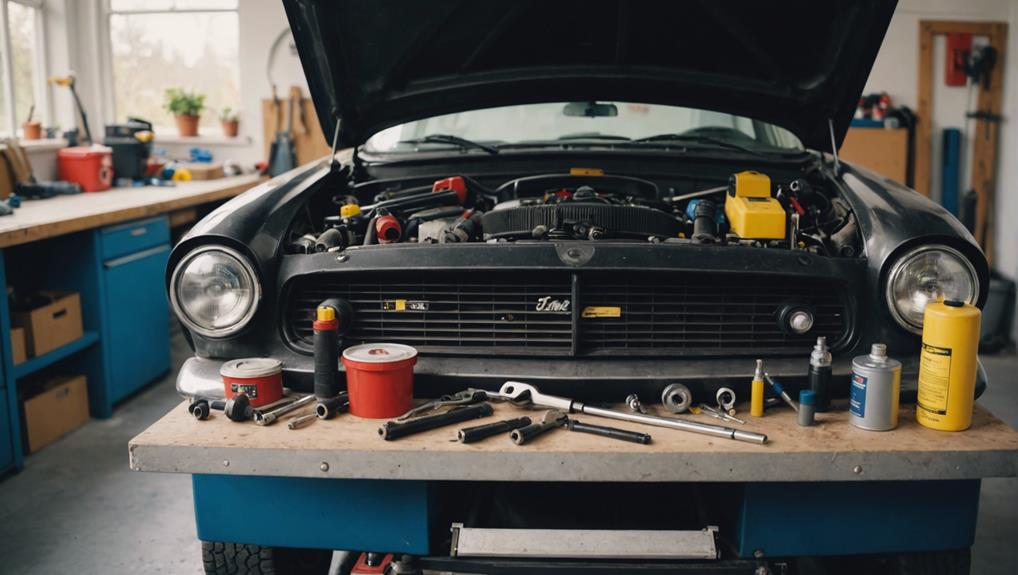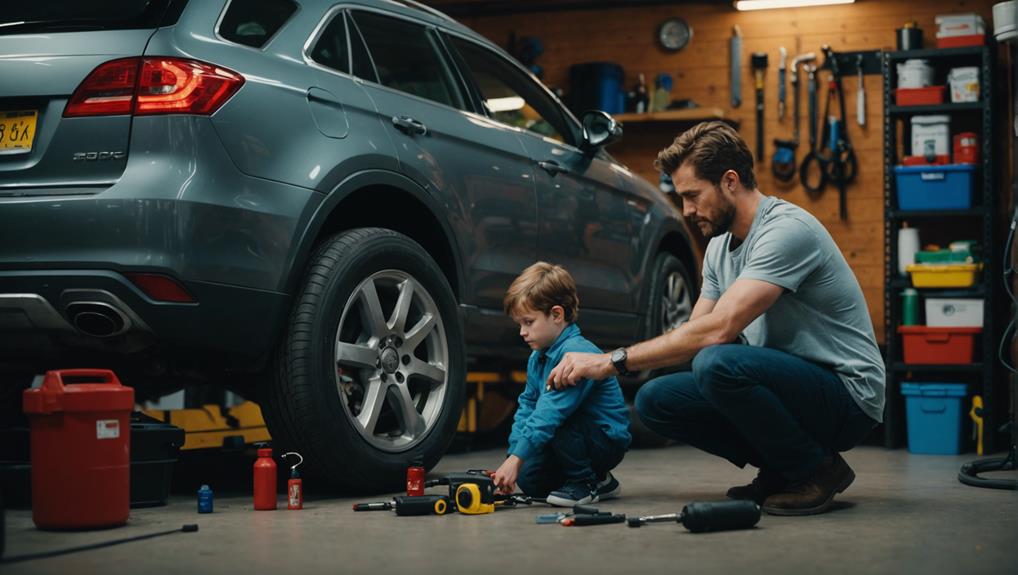You can save time and money by mastering simple car maintenance tasks that fit seamlessly into your busy family life. Start with essential tools like a socket set, sturdy jack, and torque wrench. Change your oil regularly to prolong engine life and check tire pressure to guarantee safety and fuel efficiency. Replacing air filters every 15,000 to 30,000 miles enhances performance. Keep tabs on fluid levels like engine oil, coolant, and brake fluid to maintain top performance. These easy tips can keep your car running smoothly and efficiently, and there's much more you can learn to become a DIY car maintenance pro.
Essential Tools for DIY Maintenance

To keep up with your car's maintenance at home, you'll need a few essential tools in your garage. First, invest in a good quality socket set. This will help you tackle various bolts and nuts with ease. A jack and jack stands are important for safely lifting your car off the ground. Make sure they're sturdy and reliable.
Next, you'll want a torque wrench to make sure all bolts are tightened to the manufacturer's specifications. An oil filter wrench is another essential tool; it simplifies the process of changing your oil filter. A set of screwdrivers in various sizes and types will also come in handy for different tasks.
In addition, get a tire pressure gauge to keep your tires properly inflated. A battery tester can save you from unexpected breakdowns by examining your battery's health. A funnel and a good set of wrenches will make fluid changes and other minor repairs easier.
Lastly, keep some basic consumables like rags, gloves, and a creeper for sliding under the car. Having these tools readily available will make your DIY car maintenance smoother and more efficient, saving you time and money in the long run.
Regular Oil Changes
Regular oil changes are crucial for keeping your car's engine running smoothly and efficiently. By replacing old, dirty oil with fresh oil, you guarantee that the engine's parts are properly lubricated, reducing friction and preventing wear and tear. This simple maintenance task can greatly prolong your engine's lifespan and improve fuel efficiency, saving you money in the long run.
To perform an oil change yourself, start by consulting your car's manual for the recommended type and amount of oil. You'll also need an oil filter, a wrench, a funnel, and a container to catch the old oil. First, warm up the engine for a few minutes to help the oil flow more easily. Then, locate the drain plug under the car, place the container beneath it, and carefully remove the plug to let the oil drain out.
Once the oil has drained, replace the drain plug and remove the old oil filter. Install the new filter, making sure it's securely in place. Finally, pour the new oil into the engine using the funnel and check the oil level with the dipstick. Dispose of the old oil properly, and you're done!
Checking Tire Pressure

Keeping your tires properly inflated is essential for ensuring safety and peak performance on the road. It's a quick task that can save you time, money, and stress in the long run. Underinflated tires can lead to poor fuel efficiency and uneven wear, while overinflated tires can reduce traction and make your ride uncomfortable.
To check your tire pressure, you'll need a tire pressure gauge. Here's a simple step-by-step guide:
- Find the recommended PSI (pounds per square inch): This information is usually found on a sticker inside the driver's door or in your vehicle's manual.
- Check pressure when tires are cold: First thing in the morning or after the car has been parked for a few hours. Hot tires can give a false reading.
- Use the gauge: Remove the valve cap, press the gauge onto the valve stem, and note the reading. Compare it to the recommended PSI.
If the pressure is too low, add air until you reach the correct level. If it's too high, let some air out until it's just right. Regularly checking your tire pressure can help you avoid unexpected blowouts and keep your family safe on the road.
Replacing Air Filters
Replacing air filters is a simple task that can greatly enhance your car's performance and fuel efficiency. You don't need to be a car expert to do it. First, locate your air filter. It's usually in a black box near the engine, secured with clips or screws. Open the box and take out the old filter. If it's clogged with dirt and debris, it's time for a replacement.
Next, compare the old filter with the new one to make sure they match. Place the new filter in the same orientation as the old one. This guarantees proper airflow and filtration. Close the box and secure it with the clips or screws you removed earlier.
Changing your air filter regularly can improve engine performance and extend its lifespan. Most manufacturers recommend replacing it every 15,000 to 30,000 miles, but check your owner's manual for specific guidance.
Simple Fluid Checks

Frequently checking your car's fluid levels is essential for maintaining its performance and preventing costly repairs. With a busy family life, it's easy to overlook these simple tasks, but doing so can save you time and money in the long run. Here's a quick guide to get you started.
First, take a look at the engine oil. This is the lifeblood of your car, ensuring all moving parts run smoothly. Use the dipstick to check the oil level and color. If it's low or dark, it's time for a change.
Next, don't forget the coolant. This fluid helps regulate your engine's temperature. Check the coolant reservoir; it should be between the 'min' and 'max' marks. If it's low, top it off with a 50/50 mix of water and antifreeze.
Finally, inspect the brake fluid. This is essential for your safety. Locate the brake fluid reservoir and make sure the fluid level is within the recommended range.
Remember to:
- Monitor fluid levels regularly to catch issues early.
- Use manufacturer-recommended products for top performance.
- Keep a log of checks to maintain a consistent schedule.
These steps are quick and easy, ensuring your car stays in top shape.




